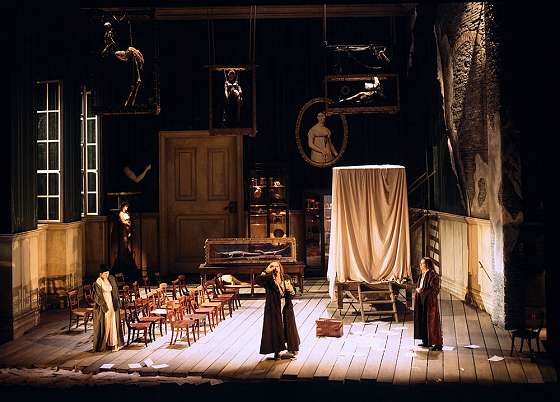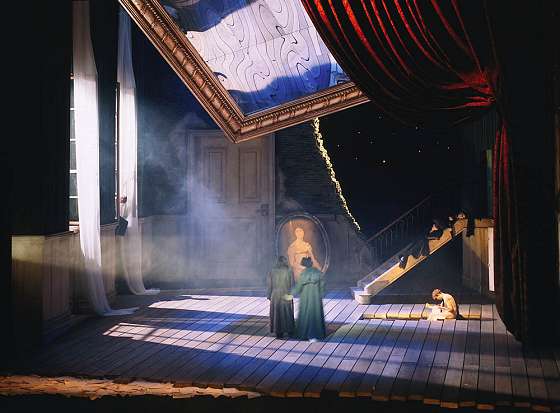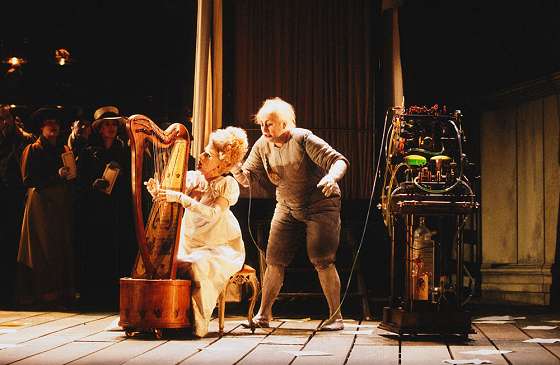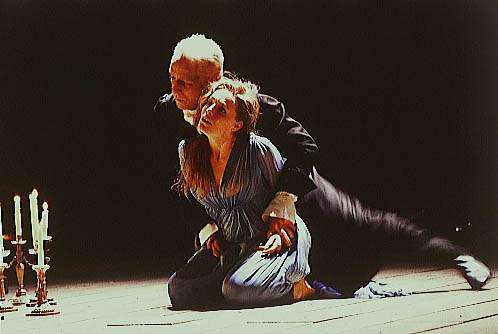Recent Opera Round-up

with RODERIC DUNNETT
1. The Tales of Hoffmann, De Vlaamse Oper, Antwerp.
The Tales of Hoffmann, Offenbach's final extravaganza and - as many maintain -
his last-minute masterpiece, is a bizarre amalgam : Baron Munchausen meets Don Quixote,
overlaid with the Faust of Goethe and Berlioz, plus a measure of Don Giovanni
(the very opera which is being performed offstage throughout the action). Hoffmann himself
is an archetypal Schumann-cum-Heine romantic, pathologically incapable of settling down :
half a dozen other E.T.A. Hoffmannesque vignettes and weirdos are woven into the action.

Charlotte Hellekant (Nicklausse), Laurent Naouri (Coppélius)
and Gerard Powers (Hoffmann)
Given the mix-and match about Offenbach's order of scenes, which Ernest Guiraud had to
lick posthumously into shape, Hoffmann needs partiuclarly skilful pasting together onstage.
De Vlaamse (Flemish) Opera's new production in Antwerp and Gent by the inventive,
imaginative and incisive Scottish director David McVicar - who staged Flander's
Idomeneo (following his award-winning UK triumph with Mozart's opera) two seasons
ago - with designs by Roni Toren, costumes by Brigitte Reiffenstuel and lit by Tina
MacHugh, starts off in a cramped, deliberately claustrophobic bedroom-cum-living room, a
tip from which emerge Nicklausse (the characterful Swedish mezzo Charlotte Hellekant) and
a bedraggled Hoffmann (Gerard Powers, a vocally powerful late replacement for Russian
Bolshoi tenor, Mikhail Dawidoff), selfconsciously crumpling up and discarding sheets of
rejected verse : you can almost smell the coffee stains and the untouched washing-up.

Gerard Powers (Hoffmann) and Charlotte Hellekant (Nicklausse)
This tiny room enlarges to become, with variants, the setting for each ensuing scene,
as if to suggest each is a compartment of Hoffmann's packed psyche, or else it an offshoot
of them. Each main scene, presented by McVicar and conductor Jean-Claude Casadesus in the
order Olympia (the doll)-Antonia (Rat Crespel's daughter)-Giulietta (the Venice scene),
is accorded visual touches that intermesh it with the rest. There is a modicum of
McVicar's characteristic surreal fingerprints, from the changing perspective of wall-mounted
pictures and the jumble of reflecting overhead glass in the Giulietta scene to a corpse - an
anticipation of Hoffmann's desperate act of Venetian street-killing - that looks like a
corner of an eerie Paul Delvaux painting, or a refugee from David Pountney's surrealist
Julietta (Martinu) for Opera North.

Laura Claycomb (Olympia) and François-Nicolas Geslot (Cochénille)
The tragic, and ultimately unavailing, efforts of Crespel (the stylish performer Marc
Claesen) to stop his daughter singing take place in a vast, desolate, emptied-out version
of the initial set, by now enlarged to proscenium size, with door handles that hover over
Antonia's head like something out of Tomb Thumb the Great or The Incredible
Shrinking Man. McVicar here keeps the action deliberately spare, as the preceding
scene, with Coppélius (Laurent Naouri) and Spalanzani (Jan Caals) in full flow, is
consciously frenetic and riddled with stage business, chorus bustle and outrageous colour.

Mireille Delunsch (Antonia) and Laurent Naouri (Docteur Miracle)
Two of the female roles are sung by Americans. Laura Claycomb's Olympia is sweet and
shrill; Stephanie Friede's Giulietta is like a rich and full-bodied wine; but the voice
of the evening - Gerard Powers' vocally splendid - though, given limited rehearsal time,
visually inept - Hoffmann apart - was the French soprano Mireille Delunsch, fresh from
her appearance at Vlaamse Opera in Mark Minkowski's acclaimed reading of Rameau's
Platée - an Antonia of especially warm, plaintive and gorgeous voice, whose
interplay with Claesen's Crespel was therefore all the more affecting. The doubled parts -
François-Nicolas Geslot as an amiably slouchy (and very Offenbachian) Andres and Frantz, and
Naouri's chameleon-like, sinuous magus of a Coppélius-cum-Dr.Miracle, lifted the acting stakes.
Casadesus drew some periodic bursts of magical playing from the workhorse Flanders Opera
orchestra, in particular the lower strings and the scattered cello solos.
Copyright © 2 April 2000 Roderic Dunnett,
Coventry, UK
|